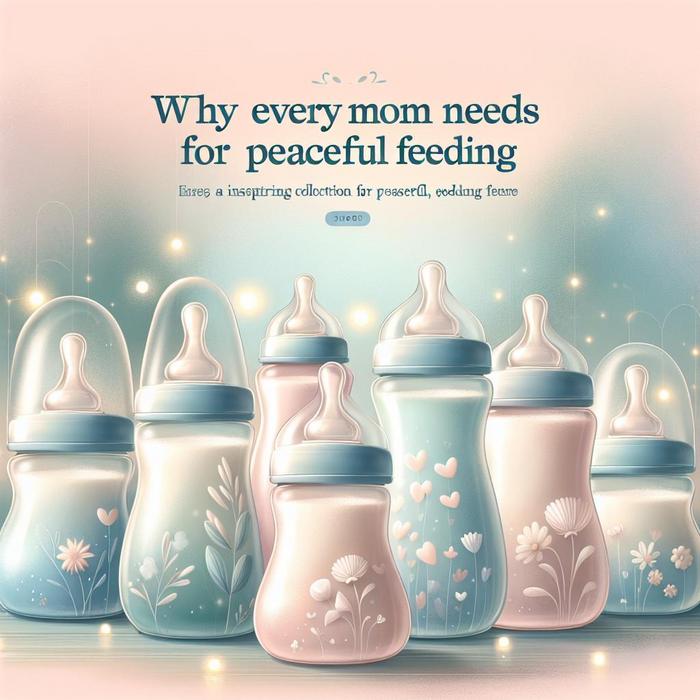Understanding the Importance of the Right Feeding Bottle
Transitioning from breastfeeding to bottle feeding can be a daunting task for many mothers and infants. The process requires careful planning and a lot of patience. One of the most crucial aspects of this transition is finding the right feeding bottles for your baby to ensure peaceful, calm feedings.
The Search for the Ideal Bottle
One of the key elements in achieving the success of a smooth transition is choosing feeding bottles that can mimic the comfort, warmth and rhythm of breastfeeding. This is where slow flow bottles for breastfed babies play a significant role.
Slow Flow Bottles: The Biomimetic Approach
Slow flow bottles are specifically designed to imitate the natural flow of a mother’s milk. This design helps babies control the flow of milk, reducing the risk of choking, spit-up, and gas.
The features of slow flow bottles include:
- Eases the transition from breastfeeding to bottle feeding
- Encourages the baby’s natural feeding behaviour
- Reduce overfeeding and colic symptoms
These bottles provide a calm and soothing feeding experience that can make this transition much easier for both mother and baby.
Pacifiers and Thumb Sucking: Relation to Bottle Feeding?
It’s not unusual for babies to suck their thumbs or use pacifiers for comfort, but where does this fit in with bottle feeding? This is a common question among parents, and the answer lies in understanding the comforting gestures of babies. Bottles, pacifiers and thumb-sucking all provide the baby with a soothing experience—much similar to breastfeeding.
The Emotional Aspect of Transitioning to Bottle Feeding
The transition to bottle feeding can evoke mixed feelings. As many mothers are aware, breastfeeding is not just about nutrition but also deep bonding with the baby. Mothers who are ending breastfeeding often go through a farewell process, feeling a sense of loss along with relief. Understanding these emotions is important; navigating through them and finding the right balance between breastfeeding and bottle feeding is crucial. A farewell to breastfeeding offers an insightful perspective on this emotional journey.
Addressing the Challenges: Breastfed Babies Who Won’t Take the Bottle
Despite careful planning and the best intentions, some breastfed babies resist bottle feeding. This can be a stressful experience for both the mother and the baby. Community support can be immensely helpful in such circumstances. Discussions between parents and early childhood education professionals help in sharing experiences, advice and solutions to deal with this common issue.
Choosing to Formula Feed
While breastfeeding is highly encouraged, it’s important to remember that every mother’s journey is unique. There are various reasons why a mother might opt for formula feeding, and it’s crucial to respect this choice without judgement. Support for mothers who choose to formula feed is part of a broader conversation about parenting choices.
Creating a Calm and Soothing Feeding Environment
Investing in peaceful feeding bottles that cater to your baby’s needs is a significant step in creating a calm feeding environment. Remember, it’s not only about feeding but also about nurturing a close bond with your baby.
Understanding Bottle Weaning
As your child grows, the switch from bottle to cup feeding is another consequential transition that comes into play. Leaving behind the comfort and familiarity of the bottle might seem apprehensive at first for babies, as they’ve associated it with their first formative relationship of comfort and nourishment since infancy.
To navigate through this shift, it’s essential to understand why, when and how the weaning should be initiated. The key is to initiate the transition gradually, allowing the baby a comfortable adjustment period. You can start by introducing a sippy cup filled with water during meal times. More tips on weaning off bottle feeding can make the process easier for you and your baby.
Maintaining Secure Attachment: Does Bottle Feeding Impact It?
There are often concerns about whether bottle feeding might interfere with the secure attachment between a mother and her baby. Secure attachment refers to an emotional bond where the baby feels safe, understood, and taken care of. It’s not solely dependent on breastfeeding.
Yes, breastfeeding allows skin-to-skin contact and eye contact that can promote secure attachment. However, the same connection can be facilitated through bottle feeding by ensuring the bottle feeding times are filled with warmth, positive contacts, and responses. Understanding the essence of secure attachment adds an insightful perspective to this thought.
Common Myths About Feeding Newborns
It’s crucial to rely on scientifically valid information when it comes to feeding newborns. Unfortunately, there are plenty of myths, often handed down through generations, that can be harmful to a baby’s health.
One such myth is about adding alcohol into a newborn’s bottle to ensure they sleep peacefully. However, it’s important to understand that this practice can harm the baby’s development and should be avoided. Dispelling myths about feeding newborns is crucial to ensure their wellbeing.
Creating Fond Memories with Feeding Time
Feeding time is more than just a routine to satiate your baby’s hunger. It’s an intimate bonding opportunity that harbours warmth, comfort, and mutual understanding, creating fond recollections for both the mother and the baby.
Sharing these beautiful moments with your little one is something every mother looks forward to, whether you’re breastfeeding, bottle feeding or weaning them onto a cup. Even celebrities cherish these moments, making them feel more special.

